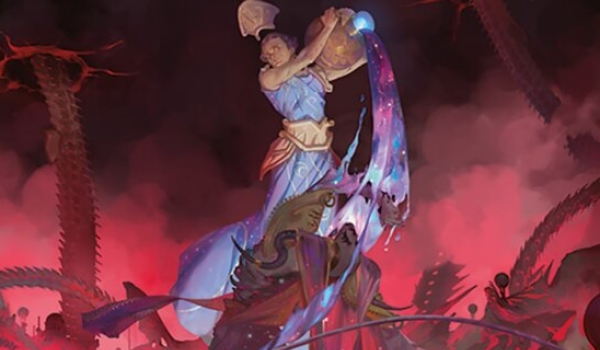Are you a Quiet Speculation member?
If not, now is a perfect time to join up! Our powerful tools, breaking-news analysis, and exclusive Discord channel will make sure you stay up to date and ahead of the curve.
Blue and UB can be a great place to navigate our draft. When we start there, however, it is tempting to ignore other paths. A first pick is often hard to cast away, when it's a first pick in the best color, we're not just worried about losing the early rare, but the powerful commons we might see later.
While March of the Machine (MOM) has generally been kind to me, I have not been immune to one of Limited's most insidious traps: clinging to the best color.
Because there are so many good blue cards, we can tell ourselves that blue is open when really we're just seeing the debris breaking off from a good color. Pivoting is an essential skill for navigating draft, and pivoting off of the format's best color or archetype intensifies that struggle.
Best Red Deck vs. Decent Blue Deck
There's a case to be made that it's better to be one of the many blue decks than the open red (or non-blue) deck. The top commons seem to support this idea.
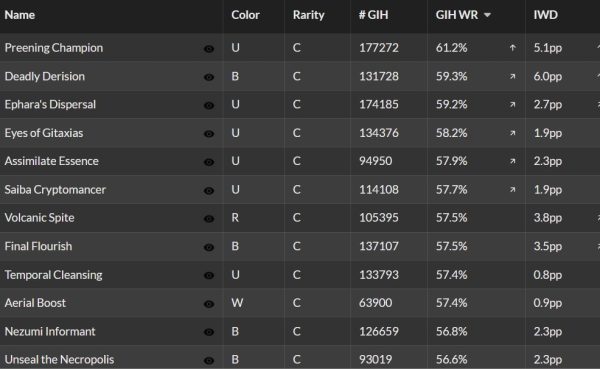
However, this doesn't take into account the context for this data. These cards contribute to winning decks. These numbers are averages, not promises of performance. This means that when players are picking these cards, there's a good chance they're playing them side by side with powerful rares and uncommons that help boost the overall win rates of the decks. If the color is overcrowded, we won't have access to those higher powered cards. So no, we shouldn't take Saiba Cryptomancer over Volcanic Spite and Final Flourish simply on the merits of GIH WR%.
Conversely, there might be good reasons to fight for a color. Say we're having success with a given archetype, particularly in the opening weeks of a format. If we know something they don't know, we'd be wise to leverage that advantage. Still, formats evolve because players learn, either from experience or other resources.
In the early days of MOM, we could collect Ephara's Dispersal and Invasion of Amonkhet // Lazotep Convert in multiples. Those days have mostly come and gone. If I'm drafting blue in MOM today, I'm expecting to fight over the color. So how do we know whether the fight is worth it?
The Reach and the Pull
In my most recent draft, I first-picked Hidetsugu and Kairi. It's a powerful card in the best color combination. What could go wrong? Second pick I took a Meeting of Minds. Third pick I took Eyes of Gitaxias. I wanted to stay in UB, so I tried to corner the market.
While both of these cards have a suitable win rate, they're not really cards I want to draft this early. I wasn't being pulled into blue; I was reaching. I wasn't responding to the signals of the draft. This was an attempt to protect my rare. Because blue is so deep, there's plenty to hold onto, but I wasn't building a strong deck. I was taking pieces and hoping things would open up later on.
The pieces I ended up takng weren't ideal. Had I seen strong uncommons or premium commons like Preening Champion, Ephara's Dispersal, or Deadly Derision, then staying in UB would make sense. Instead, I took second-tier commons. While all these cards have good win rates, the drop off between them is real. Meeting of Minds and Temporal Cleansing are a far cry from the actual best commons in the set.
Early Game and Synergy
It's hard to develop a clear plan when we're scrounging for scraps. When we look at a pack and see an abundance of options, we have the privilege of identifying the one that best fits our needs. Contested colors don't provide those options. You get what you get, and you (hopefully) don't get upset.
I drafted a lot of convoke early on. I hoped to see Ichor Drinker, Omen Hawker, and Captive Weird // Compleated Conjurer. But hope is hardly a plan. I ended up playing a reasonable, but clunky, UB deck with a middling power level.
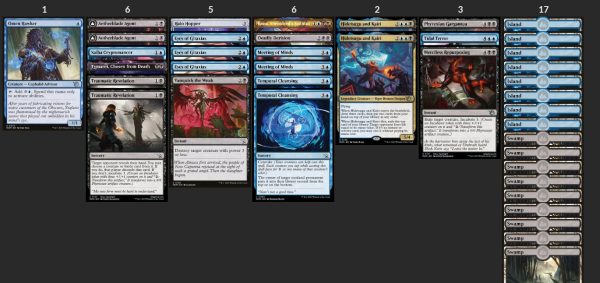
UB "Mid"-range (5-3)
Because of the inherent strength of the color pair, and because I opened an on-color bomb in pack three, I was able to build a competent deck. Still, it was clear that the colors weren't open. I needed to make adjustments based on some of the early data seen, and didn't because I was too eager to be UB.
Ambition the Angel?
When it comes to draft, we always have three options. We can stay the course, we can pivot, or we can absorb. The first major decision point I saw in the draft was an unconventional one. It came in pack three.
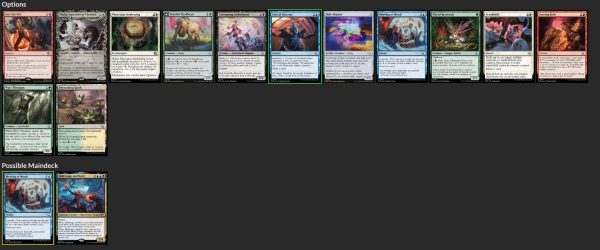
Phyrexian Awakening is a card that has played very well for me. A 4/4 vigilance is an extremely powerful body, and spreading that vigilance lets us pressure our opponents while still looking to play a long game. Instead of snapping up the enchantment,, I stayed the course with a good but not great blue card, Eyes of Gitaxias.
Even after that pick, I felt challenged by an even less conventional choice.
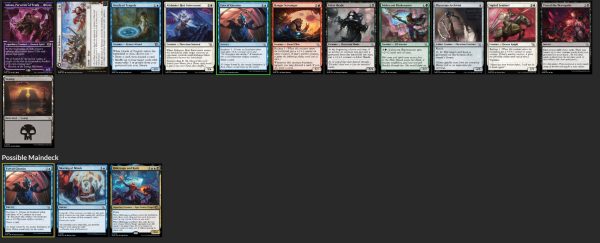
Alabaster Host Intercessor is a fine card. It's not as good as the card I selected, Eyes of Gitaxias, but it represents something much greater. While black had yet to yield a realistic option, white had shown multiple reasonable selections in picks three and four. Had I taken the Alabaster Host Intercessor, I would have given myself a chance to remain blue, but with more flexibility to incorporate the seemingly open white cards later on. While UW is primarily seen as a tempo archetype in this format, it can certainly play a more controlling strategy with counterspells, Cut Short, answers, and bigger threats.
While the white cards wouldn't have been committal it would have given me more flexibility. Hopefully I could still splash the bomb, but if not I'd at least be in an open color.
Sight Beyond Sight
Part of navigating drafts late in a format involves knowing the possibilities. The slower UW deck is not a common off-road, but UR Convoke is. Pack two offered us something I missed in the moment.
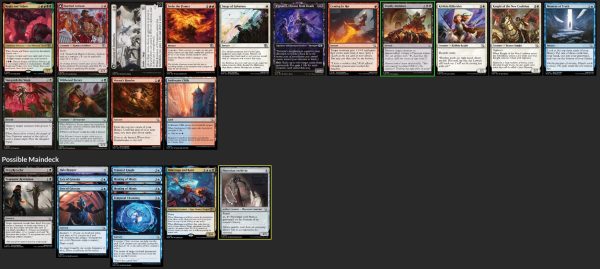
I was overjoyed to see my first premium black card, Deadly Derision, here in pack two. This would give me the support I needed to continue my dream of building a functional UB deck. Good ol' four-drops. Nothing beats four-drops.
But what else do we see? (Hint: It's another four-drop... sort of). In retrospect, I wish I'd considered Stoke the Flames. It's an off-color card, but it's not off-plan.
At this point, we already have three convoke cards. We haven't seen any premium blue cards, so it's unlikely we'll get Captive Weird; Ichor Drinker has been, thus far, MIA. Pivoting into UR opens up the possibility of leveraging Ral's Reinforcements as a high-value card available late in packs two and three. While we currently have little to support these convoke cards, red gives us the best option to do so. We can still try to splash our rare, but we don't have any real reason to be black besides the first pick.
Conclusions
Hindsight is 20/20. While I think staying blue in my seat may have been justifiable, staying black was clearly wrong. While I potentially could have splashed the rare, which I was lucky enough to open a second copy of, I should have been more ambitious and open-minded when it comes to navigating this draft. However, that can be a big ask when the winds of fate blow you towards the best archetype.
I could have supplemented the deck with a third color or pivoted into a different archetype had I not failed to read the signs. As my mediocre deck got to five wins, I think this represents an above-average outcome based on the controllable factors. I don't think it's a disaster to be UB. It's a powerful archetype for a reason. Both colors are deep, and though neither seemed particularly open, this pair offers a puncher's chance. Still, I wish I had been more ambitious. I think I could have done better.
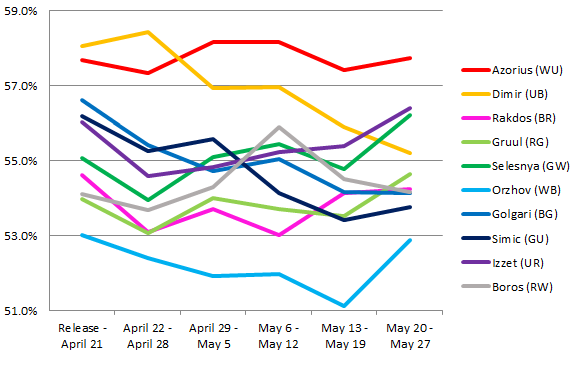
I wanted to end with a note on the following graph. Noted MTG data analyst Sierkovitz tracked the changes in win percentages over each week. While UB has been the boogeyman of the format, in recent weeks it has experienced a severe drop-off.
The color has not gotten less powerful. The format has just evolved. The word is out on UB, and while the color is deep, it's a known quantity. People want these cards. The archetype has fallen closer to the rest of the pack as players fight over its pieces. So, make sure to read the draft, and not just assume that the deep colors will provide. The format is still evolving. Are you?


